Let’s start with answering the main question “Can a solar generator power the whole house?”. Yes, it can.
When it comes to the backup power solution for the house, most people prefer gasoline or propane generators. So, if a solar generator can power the whole house, why don’t people go for that? After all, it is free energy, and the operating cost will be next to none.
That is because solar generators which are available in the market are not designed to power the whole house, whether it is a small unit or a bigger one. Solar generators can power your essentials like refrigerators, TVs, lights and can charge your electronics.
But, when it comes to larger appliances like a central AC system or a washing machine, then you will need something more powerful. So, why have we stated that a solar generator can power the whole house? Because it can, not these ready-made units but the custom made ones.
If you want a solar generator to power your whole house, then it will need to be custom-made based on your power needs. You will have to decide all the things like the size of a battery, number of solar panels, etc., which makes it possible for a solar generator to run every single appliance of your house.
In upcoming sections, we will discuss this topic in more detail. So, keep reading.
Here’s the highest power output solar generator in the market currently with 3024 Wh capacity and 2000 running watts.
Table of Contents
How to Calculate the Power Needs of Your House?
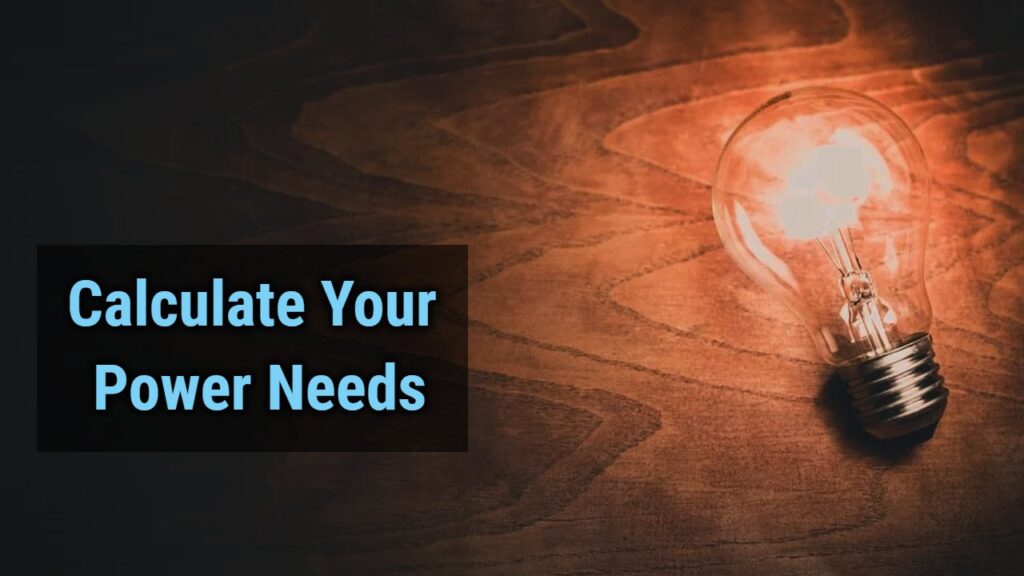
Before you try to build your custom-made generator, it is important to know your power demands. It will make the task much easier, and you won’t end up with a lower power generation or pay more for the components you never needed. So, how can you calculate your power needs?
This is a simple process. To know your total power demand, which you would like your solar generator to power, you need to add the power rating of all the appliances that you want it to power.
The ratings of all the appliances will be mentioned on the appliances themselves, but if some appliances don’t have them, then you can refer to the owner’s manual or see them online. Once you have all the power ratings, then add them up; that is the total power that your solar generator will need to power.
Also, note that the power needs will be different for a different house. A larger house will need more power, while the power requirement of a smaller house will be less.
Once you know your total power need, you should decide to have a solar generator that can provide 10% more power than your actual need. This is to be on the safe side, and it is not a good idea to run your generator at its full capacity.
What is a Solar Generator?
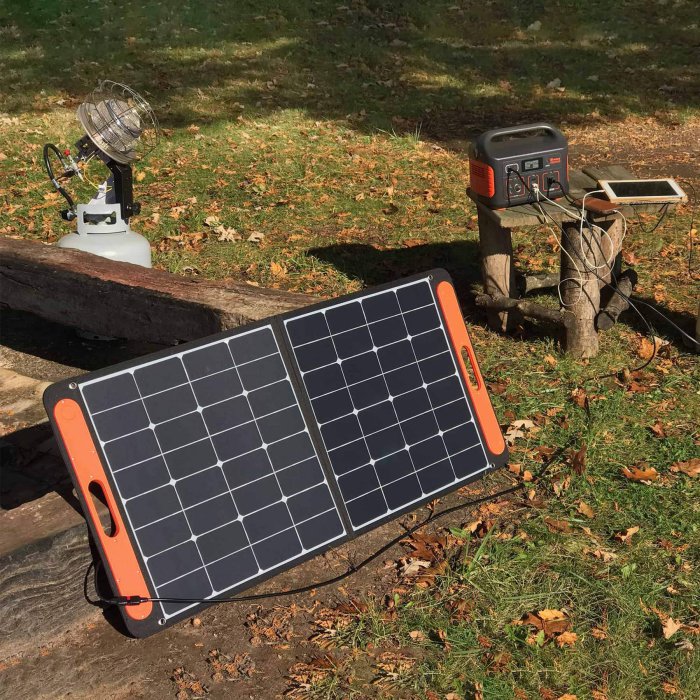
If we define it in a broad sense, then any system that generates power from solar energy is known as solar generators. But, what most people understand when they hear the term solar generator is a portable, small unit that can store the power from the sun with the help of solar panels and supply it back when it is needed.
A solar generator comprises a few key components that help them to harness the solar energy and store it in a battery system. This energy will then be utilized to power different power appliances. These solar generators are mostly used for RV camping, tail-gating, adventure trips, etc.
How Does a Solar Generator Work?
A solar generator has four main components. Solar panels, a charge controller, a battery, and an inverter.
A solar panel is an interface that converts solar energy to electrical energy. Solar panels are made of crystal conductors which harness the energy from solar rays. A few years ago, solar panels were not as efficient and cheap as they are now.
This is also one of the reasons why solar generators are getting popular day by day. Solar panels charge the battery during the day.
Solar panels will keep supplying the energy to the battery. If it is not stopped, then the battery will overcharge. You need some kind of mechanism to prevent that from happening; that’s when a charge controller comes into the picture. It controls the energy from the solar panels to avoid overcharging.
It is one of the key components which ensures the proper functioning of a solar generator. It will also shut off the generator when the battery charge falls below a critical level.
It is important that we mention that solar panels, charge controllers, and batteries produce DC energy. This is good to recharge portable electronics, but you can’t use it to power the home appliances as almost all of them use AC electricity. So, to convert the DC to AC, an inverter is used.
The energy from the solar panels is stored in a battery, and most of the solar generators will have a Li-ion battery due to its high energy density. It will be able to power many appliances for longer than you could have imagined a few years ago.
How to Connect a Solar Generator to Your House?
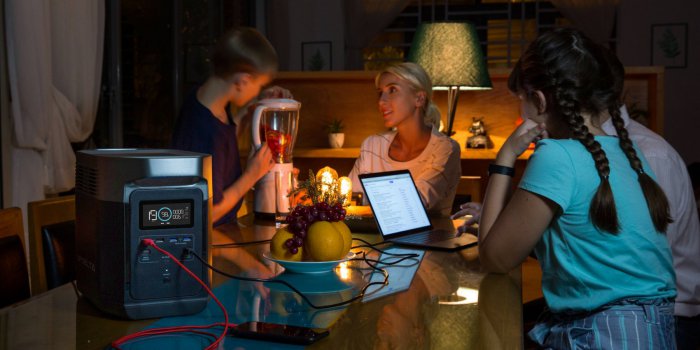
There is more than one way to connect a solar generator to your house, depending on the type of solar generator you decide to have.
You will need to first install the solar panels on your roof or the ground if you have a custom-made one to power the whole house. If you have a ready-made solar generator, then there will be no need for anything. Just mount the solar panels on the ground and connect the appliances to the sockets on the generator, and it is done.
On the other hand, for custom-made generators, you will need to perform some tasks. First is the mounting of solar panels on the roof; you can do it yourself or hire a professional. Then you will need batteries, or maybe not.
This will depend on whether you are installing a solar system as a backup solution or as a replacement for grid electricity.
As a backup solution, there will be no need for batteries, but if you plan to use it as a replacement, then you will need batteries. After that, if you have a battery, then an inverter will need to be connected to it otherwise directly with solar panels.
The inverter is to convert the DC electricity to AC electricity. Then the inverter needs to be connected to the home grid.
Moving on, if you have a battery, then make a connection to the circuit breaker and shunt; this is to avoid overloading. Then, make a connection to the AC fuse box of the house from the inverter. Also, keep an arrangement to switch back to grid power. It will be needed when you use up all the energy from the batteries.
Different Battery Types to Choose from
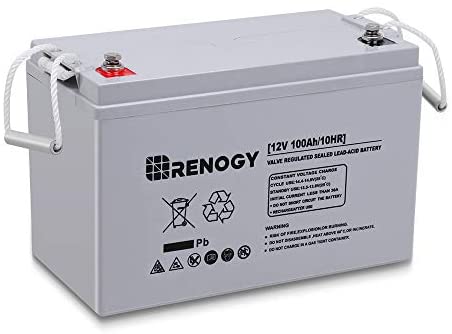
Energy harvested from the solar rays will need to be stored somewhere before it can power the appliances of the house. This solar energy is stored in a battery. So, what type of batteries are there in the market and which one you should choose.
Let’s see. But before that, you will need to decide the size of a battery which you should have already calculated as mentioned in the last section.
Li-ion Batteries
This battery type is the product of the latest development in battery technology. It is of superior quality and way better than lead-acid batteries. Li-ion batteries are the most expensive ones, so if you have a budget, then we strongly recommend going with this.
Lead-Acid Batteries
Lead-acid batteries have been in the market for more than a half-century now. These batteries are a budget-friendly option.
Flooded
Flooded lead-acid batteries have a lifetime of 5 to 6 years, and this is the cheapest option you can go with. Note that they will require periodic maintenance. A distilled water or diluted sulphuric acid will need to be added to the electrolyte to equalize the charge. If they get highly discharged, then it will lead to the crystallization of electrodes.
Moreover, there will be built of hydrogen gas, which should be properly vented outside.
Sealed
Sealed lead-acid batteries are quite better than flooded lead-acid batteries and also more expensive. The advantage of a sealed battery is the absence of maintenance needs. You won’t have to add the distilled water to it every month. But note, these batteries will last for 3 to 5 years only. It will also need to be vented.
Advantages of A Solar Generator
You will appreciate the number of benefits a solar generator has to offer, and there are many.
A solar generator is a great choice if you live in an area where most of the time, it stays sunny. This will keep charging your solar system every day, and you will be able to reduce your electricity bill by partially powering a few appliances of the house from a solar generator.
Moreover, you won’t have to pay a penny for this energy, and it is freely available from the sun and that too in abundant quantities. So the operating cost of the unit reduces to almost nil. You just have to pay for the purchase and installation, then after, you can reap the benefits.
When you opt for conventional generators, you are contributing to the deterioration of the planet. The exhaust gases of the conventional generators harm the environment. With solar generators, you won’t have to worry about that, and there will be no exhaust from the solar generator. It is an environmentally friendly and clean power source.
Other than that, with solar generators, you won’t have to deal with the loud noise; that is one more thing down. They are impressively quiet units. The reason is the absence of any moving parts. No moving parts mean no wear and tear, so you won’t have to spend on the replacement of parts, which is the case with conventional generators.
Disadvantages of A Solar Generator
Solar generators also have some downsides, which we have mentioned below.
As stated, solar generators have a minimal operating cost, but their initial cost is much higher, more than portable gas generators. So, if you decide to install a solar generator, then you should be ready to make the initial investment.
But it will recover over the years because it has a very low operating cost and a very long lifetime, provided you invest in a good solar kit.
Another major disadvantage of solar generators is their charging speed. It takes its time to get fully charged. Moreover, Sometimes charging will not be possible at all. So, the satisfactory function of solar generators depends on the weather conditions.
During cloudy weather, you won’t have power. A single solar panel of 100-watt will charge a medium generator in about 7 to 9 hours, depending on the solar intensity.
Moving on, you can’t use the solar generator to power the whole house unless you make the custom installation. A ready-made solar generator won’t be able to power the heavy appliances.
Conclusion
A solar generator can power a whole house, it is possible, but you will need to build a custom one for your needs. How you can install it at your house, which we have discussed. If you are not comfortable with doing the installation yourself, then you should hire a professional.
A solar generator can power the house in blackouts or on a daily basis. Once it is installed, it can share the load, so your electricity bill will be reduced. It is important to note that this is not a replacement for grid electricity as it is not that reliable. You can expect a solar generator to power the house as long as the weather is not cloudy.
Moreover, once you install a solar generator, it will keep supplying power free of cost for the rest of its lifetime, which is about 35 years.

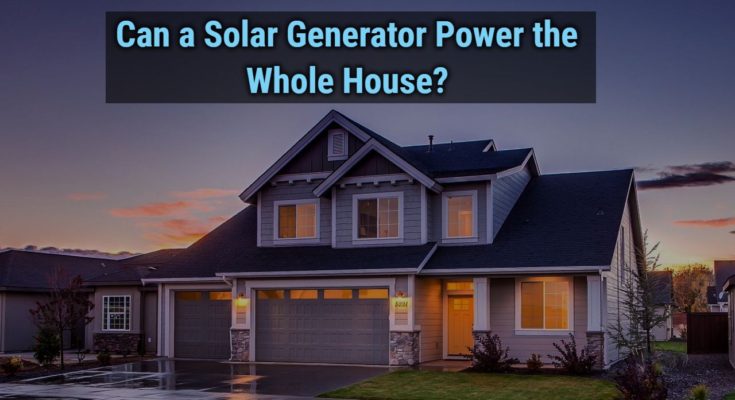
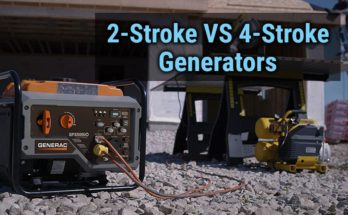
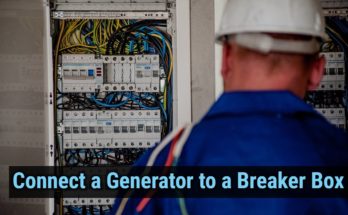
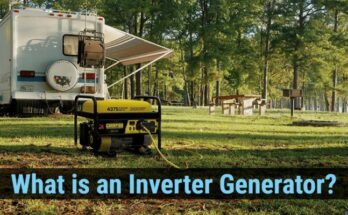
Thank you for your advise. Would you be able to tell us which brand is best solar generator you would recommend during a blackout of several days, like we had in Texas last February 2021. It would be awesome if the one you recommend can power electric water heater and refrigerator. Or, is there one to power whole house?